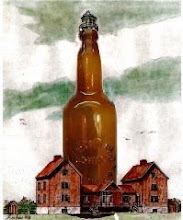By Patrick Orr The American craft beer movement is just over 30 years old — and the people who started it are still driving the ship.
Yes, there were some brewing pioneers in the mid-1970s who were emphasizing artisanal values and making the first modern American craft beers — like the venerable Anchor Brewing Co. and New Albion Brewery in Northern California.
For me, the movement begins with Anchor but is defined by the Sierra Nevada Brewing Co., which celebrated its 30th anniversary in November 2010.
For those of us who were drinking such beers in the mid- to late ’80s, the craft beer universe looks a lot different now. So many brands that were big then are either gone, plodding along or figuring out how to be relevant again.
I remember back in the day when I would walk into a package store and have to pick from Dock Street, Oldenberg, Pete’s Wicked Ale, a Samuel Adams Lager, or a Sierra Nevada Pale Ale. There might be a Red Hook.
Now look at what we have to choose from. The Brewforia Beer Market in Meridian carries 600 different craft beers to chose from.
When Ken Grossman opened Sierra Nevada for business in 1980, there were about 50 breweries in the United States.
At the time of the company’s 30th birthday in November, there were more than 1,500 breweries across the country — and the only craft brewer to sell more suds is the Boston Beer Co., which makes the ubiquitous Samuel Adams beers.
Sierra Nevada is the sixth-biggest brewery in the U.S. — behind Anheuser-Busch, Miller-Coors, Pabst, Yuengling and Boston Beer Co. — yet its products still taste like they were created with the loving care of a small, hometown brewery.
With so much competition, how has Sierra Nevada stayed relevant and vital for so long? I say it comes down to three things: quality control, a spirit for innovation and a decision about five years ago to increase its brewing capacity at its Chico, Calif., brewing plant.
“In the early days, it was all that we could do to get enough beer out of the brewery to fulfill orders,” said Bill Manley, Sierra Nevada’s brewing communications coordinator.
The plant upgrade was big enough to allow the brewery to meet all its orders with room to grow, Manley said.
Since its brewmasters always made small batches of specialty beers in Chico, the company made a strategic decision to start putting those into bottles and out onto store shelves in 2007. This was excellent timing, as more and more people were turning on to flavorful beer.
“We felt that we had an opportunity as one of the pioneers of the movement to help introduce more beers in more styles across the country ... and frankly, sharing more of our story with our fans all across the country,” Manley said. “We feel like it is our role as craft brewers to continually challenge tastes and to help advance the greater cause of better beer.”
“They have really stepped up the innovation over the last several years,” said Paul Gatza, director of the Brewers Association. “They are an industry leader that always pushes quality.”
Recent sales figures show that Sierra Nevada sold 786,000 barrels of beer nationwide in 2010, Gatza said. That is a 9 percent increase over the year before — at a time when traditional beer sales are flat and the nation’s economy is just crawling along.
When you walk into a good beer store now, you are likely to find at least five or six products from Sierra, including year-round products like incredibly popular Torpedo extra IPA or Kellerweis wheat beer. There will be a seasonal, like the Glissade golden bock beer or the most excellent Bigfoot Barleywine-style ale (which should reach the Boise market by late February or early March, a little later than usual) in the cooler, as well.
Saturday, February 5, 2011
Subscribe to:
Post Comments (Atom)



No comments:
Post a Comment